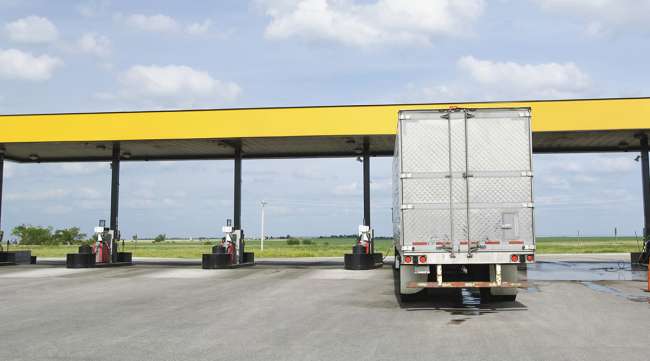Senior Reporter
Average Price of Diesel Inches Upward by 0.7¢ to $2.403

[Stay on top of transportation news: Get TTNews in your inbox.]
The national average retail price of diesel has increased seven-tenths of a cent to $2.403, according to the Energy Information Administration.
Even with the increase, the price of trucking’s primary fuel is 66.7 cents a gallon less than it was at the same time last year.
Also, gasoline increased much more sharply, jumping 6.2 cents to $2.098 a gallon.
U.S. average on-highway #diesel fuel price on 6/15/2020 was $2.403/gal, UP 0.7¢/gallon from 6/08/2020, DOWN 66.7¢/gallon from year ago https://t.co/J1pSko7q3N #truckers #shippers #fuelprices pic.twitter.com/fllkTab9gf — EIA (@EIAgov) June 16, 2020
The diesel price increased in several regions surveyed by the EIA — Central Atlantic, Midwest, Gulf Coast, West Coast, the West Coast excluding California, and the state of California.
It decreased in New England and the Rocky Mountains, and was flat on the East Coast and lower Atlantic regions.
The most expensive diesel in the nation remains in California, where prices increased by 2 cents a gallon to $3.218, but it is 78.8 cents cheaper than it was a year ago. California’s 2-cent increase was the biggest in the nation.
The least expensive fuel is in the Gulf Coast region, where prices increased two-tenths of a cent to $2.174.
Hudson, Ill.-based Nussbaum Transportation is one of many trucking companies that aggressively works to manage its fuel usage.
Chief Financial Officer Bill Wettstein told Transport Topics the lower cost of diesel has had little impact on the trucking company’s profitability because the fuel surcharge prices are factored into contracts and if the price of diesel drops, so does the surcharge.
“On a long-term profitability basis, there is really minimal impact because so much of our freight is contracted, and we have a fuel surcharge that rises and falls with the price of fuel,” he said.
U.S. average price for regular-grade #gasoline on 6/15/2020 was $2.098/gal, UP 6.2¢/gallon from 6/08/2020, DOWN 57.2¢/gallon from year ago https://t.co/rWygfuWaKq #gasprices pic.twitter.com/KRBa4nUD1T — EIA (@EIAgov) June 16, 2020
Meanwhile, British Petroleum announced June 15 that it is writing down as much as $17.5 billion of its assets, and the British energy giant might decide to leave some of its gas and oil in the ground, rather than develop it, because of lower fuel demand due to the coronavirus.
BP said it believes the pandemic will have a lasting economic impact, leading to lower worldwide energy demand and falling prices. The company also said it believes the virus could increase the shift to more renewable forms of energy, and that governments might direct some of their economic stimulus packages to more climate-friendly initiatives.
There is additional evidence that in the United States, domestic energy production is in a slump because of the low cost of oil when compared to a year ago. For example, Baker Hughes’ weekly rig count, which tracks the number of operating oil platforms, fell to 279 on June 12. That’s down 71% or 690 rigs from the same period a year ago.

COVID-19 has placed significant strain on many freight networks. So how are third-party logistics providers adapting to meet these challenges? Host Seth Clevenger chats with two 3PL executives who have had firsthand experience contending with this crisis. Hear a snippet, above, and get the full program by going to RoadSigns.TTNews.com.
In its latest forecast, EIA said U.S. crude output is forecast to drop to 11.6 million barrels per day in 2020 and 10.8 million barrels per day in 2021 from 12.2 million barrels per day in 2019.
The American Transportation Research Institute and other groups have noted that the average speed of trucks has increased in many rural and urban areas because of fewer cars on the road and less traffic. ATRI and the North American Council for Freight Efficiency research has shown that higher speeds mean higher fuel consumption.
Wettstein said Nussbaum has speed limited on most of their 450 trucks to 65 mph to conserve on fuel, and there are no plans to increase the speed.
“A lot of our drivers are running 61, 62 miles per hour,” he said. “That’s our sweet spot.”
Want more news? Listen to today's daily briefing:
Subscribe: Apple Podcasts | Spotify | Amazon Alexa | Google Assistant | More




